Gundam Reconguista in G Review
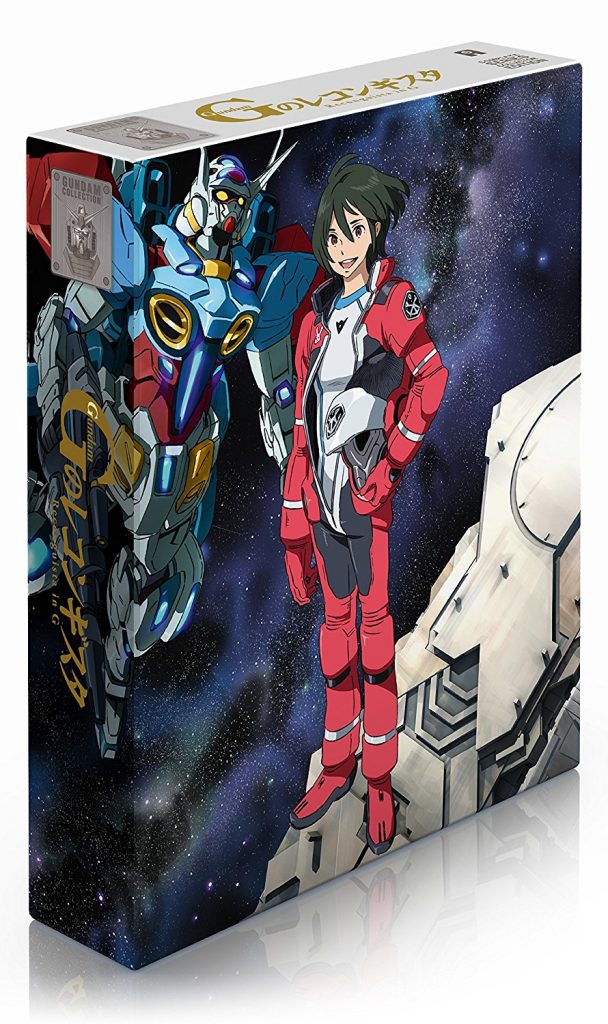
“About time!” screamed Gundam fans when Gundam Reconguista in G was announced. Yoshiyuki Tomino, the man behind the original 1979 Mobile Suit Gundam series, was returning to write and direct a Gundam series for the first time since 1999’s Turn A Gundam. In a world where recent Gundam series had been either heavily kiddie-focussed (Gundam Build Fighters) or just plain bad (Gundam AGE), the return of “Kill ‘em all Tomino” as director was pre-emptively heralded as a revival of Gundam’s glory days. The fans hyped themselves up, eagerly anticipating new and interesting worlds, philosophical musings on war, and major characters getting suddenly killed off.
Then Gundam Reconguista in G finally arrived, and reaction was… mixed. Some claimed it was a masterpiece, labelling it Tomino’s most impressive work yet; others dismissed it as a confusing mess. After the series had finished airing, Tomino himself famously said of his work that “I’d only get 15 points out of 100… Frankly, I didn’t think it would be this horrible.” However, he did go on to imply, in his trademark way, that people today weren’t clever enough to fully appreciate it, and that he would be vindicated in 50 years’ time. Now that Gundam Reconguista in G, G-Reco for short, has reached British shores in the form of Anime Limited’s Limited Edition Blu-ray release, we must ask the question: is G-Reco the magnum opus of a genius, or the confused ramblings of a disgruntled OAP? The answer is somewhere in the middle…
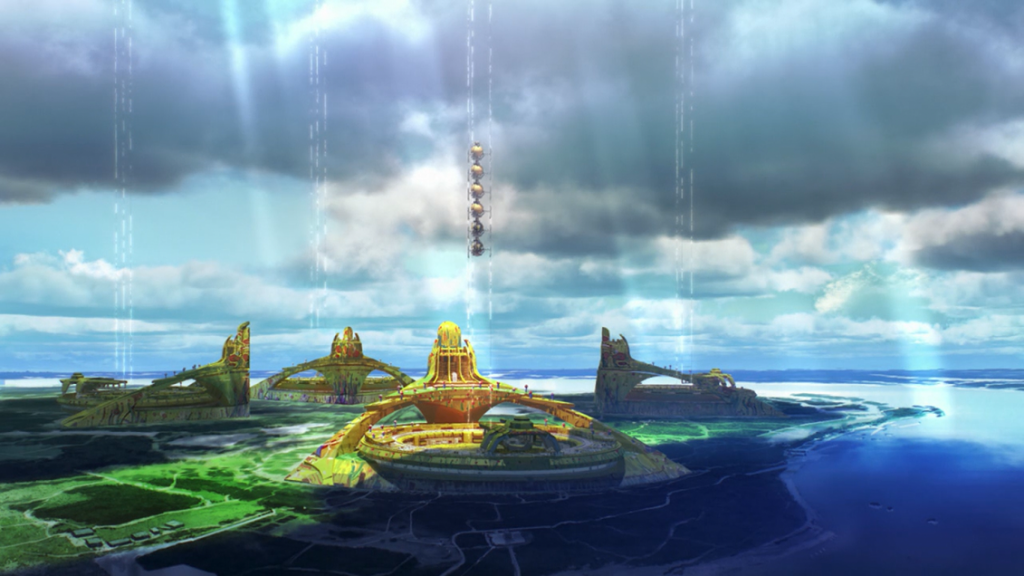
For decades the nations of Ameria and Gondwan have been at war, with the Capital Territory caught between the two as the owner of the Earth’s space elevator, Capital Tower, and ostensibly a neutral party. In this future world, certain technology is forbidden and humanity is forced to rely on Photon Batteries for energy, which are sent down to Earth via the Capital Tower by mysterious space entities. Ameria wants to reverse engineer these batteries so that the Earth may gain independence from relying on the space people, but the teachings of the Capital Territory’s religion forbids it. Ameria, Gondwan and the Capital Army are all drawn into an arms race as they break the taboo on producing space weaponry, using the threat from the other parties as justification. This draws the ire of the spacenoids who, it turns out, have been producing their own weaponry, and have their own plans for Earth’s future… Into this situation falls, quite literally, the G-Self, a mysterious mobile suit which seems poised to turn the tides of war in favour of whoever gets their hands on it. Bellri Zenam, a young recruit of the Capital Guard, manages to retrieve the G-Self from the pirates who first grabbed it, but takes a romantic interest in its beautiful pilot, Aida. When Aida escapes from the custody of the Capital Army, Bellri goes with her to the pirate ship Megafauna, and unwittingly gets dragged into a war which he cares little about.
While that may seem excessive as a plot summary, believe me, it’s barely scratching the surface of G-Reco’s story. That is, in fact, the series’ primary weakness: it attempts to cram far too much content into a 26-episode run, meaning that there is always a whole lot happening, but no time to explain it. As such, Tomino makes liberal use of the oft-ignored, particularly in anime, storytelling mantra of “show, don’t tell”. While many anime feel the need to explain every detail of the show’s history and setting through excessive exposition, G-Reco just drops the audience right in. It gets straight into the plot and then describes the world in pieces along the way, so there’s a lot of time spent wondering what the hell is going on: why are these people fighting; where do these spaceships come from; what’s this taboo thing; why does the Megafauna’s captain have a woman wearing a bikini painted on his chair? (Okay, the last of those may be slightly less integral to the plot).
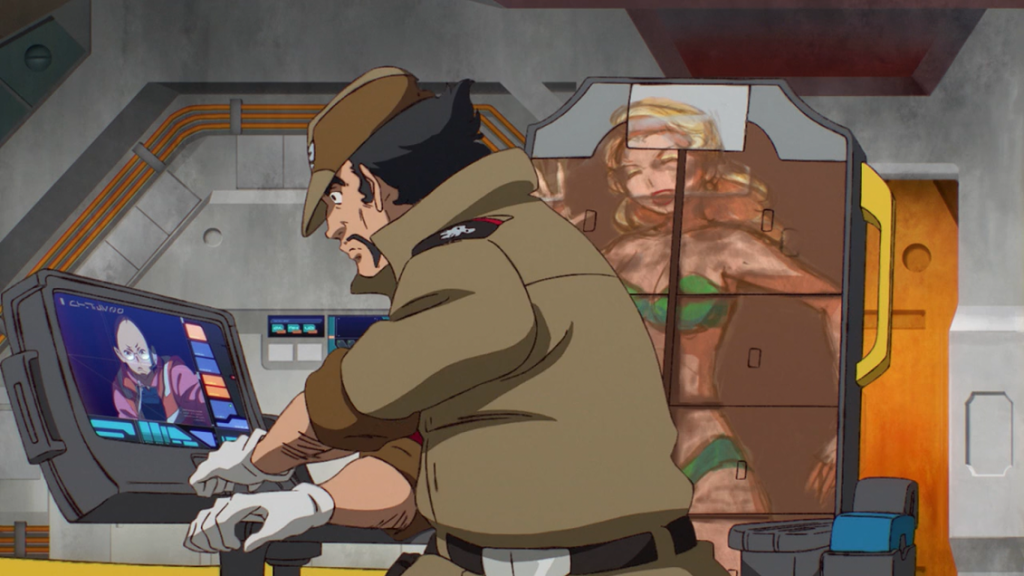
G-Reco is therefore difficult to follow, and this is the main gripe that people seem to have with it. Toshio Okada, co-founder of anime studio Gainax and now an ‘anime scholar’, said of the series, “Gundam Reconguista is really bad!… I watch a fair amount of anime, and I can’t figure out what’s going on. Ordinary people watch this and don’t know what’s happening, but Tomino thinks it has to be like this.” I take issue with this view. While things do move at a breakneck pace, and it is sometimes necessary to make use of the rewind button to fully grasp the meaning of what’s just been said, with a little effort it does (mostly) make sense. Honestly, I found this understanding process to be part of the appeal – it made watching G-Reco more of an active experience, akin to, as silly as it sounds, reading a mystery novel and trying to work out the culprit. But all the effort I put into following G-Reco was more than paid off by the depth of the world on offer.
In fairness, it doesn’t help matters that every other word out of the characters’ mouths is one that Tomino has dreamt up: for example, when a character says, “Klim, I’ll position the Hecate behind the Salamandra and take on the Garanden,” you better have picked up the meanings of those four proper nouns or you won’t have a clue what’s going on. This is nothing new for Gundam, which thrives on its made-up names, but when there is so little exposition it makes these things more difficult to follow than usual.
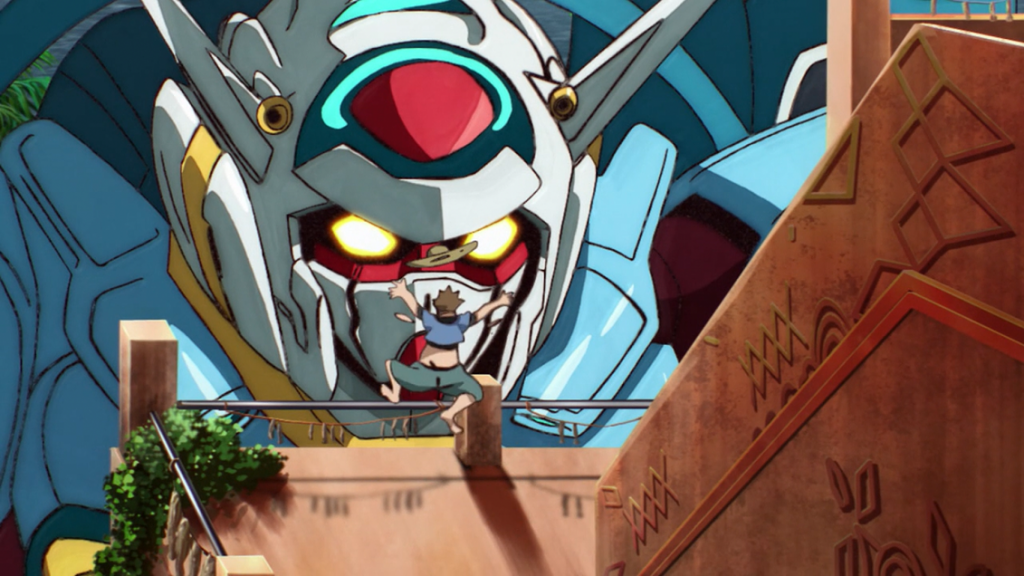
There are other symptoms of the story being rushed. One is that while characters’ motivations can be interpreted, they are rarely properly shown. In an early battle Bellri chooses to fight against the Capital Army on behalf of the pirates, despite himself being from Capital Territory. While we can infer from his single glance towards Aida that he’s probably doing it for her sake, we aren’t shown any of the inner turmoil that a character must presumably experience when betraying his friends and family in such a way. Rather than this being poor writing, I believe it’s simply that Tomino and co. didn’t have the running time spare to dwell on the emotional side, and needed to plough onwards with the battle. This isn’t a one-time thing; characters often become either allies or mortal enemies at the drop of a hat, and then flit back and forth between the two with little justification. Tomino has always been one for characters changing allegiances, but in the past he’s handled it better than he does here.
It is worth noting that the tone of G-Reco is mostly quite light-hearted, at least by Gundam standards. Despite engaging in many battles, it is rare that the characters feel as though they are in any real danger, and for the first half of the series it seems as if Tomino has outgrown his “Kill ‘em all” moniker somewhat. However, once the action moves to space and mobile suit pilots can no longer hop out of their cockpits once things go wrong, the death toll does increase quite drastically; even so, there is relatively time spent bemoaning the horrors of war, something which is typically a staple in Gundam.
Humour is more of a focus than any moral preaching, and G-Reco’s comedic edge really adds to the series. We are treated to some classic toilet humour when Bellri is forced to use the G-Self’s ‘facilities’ to go number 2, while awkwardly sharing the cockpit with three girls. Another highlight is when a ship’s captain is asked to pull up data on an attractive enemy commander, but inadvertently opens a load of her bikini pics alongside her battle statistics. Not all jokes are so bawdy; my favourite is the Amerian Lieutenant Klim Nick, who insists on calling himself “Genius” Klim. The rest of the cast consider him to be a bit of a hot-headed idiot, but make use of his nickname in a sardonic way – a subtlety that the genius himself never picks up on.

The setting of G-Reco is no doubt an interesting one, with Earth being caught in a stand-off in which all parties both fear the mysterious spacenoids and their superior technology, and yet also want to use them to further their own schemes. A nice twist is that even within this new setting, much of the core of G-Reco is borrowed from the original Mobile Suit Gundam. It has a ragtag crew roaming around on a spaceship which relies mainly on a single mobile suit, it has cool mechs, a diverse cast of characters, and space politics. There is a more literal link to the old series, too: G-Reco is set around 1,000 years after the Universal Century era, meaning that while it technically takes place in the timeline of previous series, this has little material impact on the plot. It does allow for a few cool mobile suit cameos though, either as statues in museums or as ruins scattered around old battlefields.
Industry veteran Kenichi Yoshida, who previously worked with Tomino on Overman King Gainer, outdid himself with G-Reco’s unique and brightly coloured character designs. His achievement becomes even more impressive when one considers the size of the cast; the only downside of this large cast is that it sometimes feels like a waste that an interesting character can end up getting only two and a half minutes’ screentime before they explode in a fiery death.
It wouldn’t be a Gundam series without an adolescent mobile suit prodigy as the main character, and Bellri fills that role pretty well. He initially doesn’t take much interest in the world around him and tends to go with the flow, but he does eventually develop more of a personality and his own reasons to fight. We also have that other Gundam staple, the protagonist’s masked rival – this time named, hilariously, Captain Mask. Mask’s motivations are less amusing than his codename: he is from a race of people called Kuntala, a group that were once cannibalised during food shortages in ancient times, and are still racially discriminated against. Mask’s goal is to succeed in battle so that he may bring pride to Kuntala people, and change the rest of humanity’s perception of them – however, this noble motivation becomes corrupted as Mask fights, until he grows less concerned with improving the status of his own people than with tearing down those from more privileged backgrounds.

There are a lot of appealing secondary characters – one of my favourites was Happa, the Megafauna’s disgruntled mobile suit engineer, who openly tells Bellri that he’s only working on improving the G-Self so that it will be able to better protect him. While most of the Megafauna’s crew are great, the other particularly notable character is the Megafauna’s attractive helmsman, the appropriately named Steer, who always seems to be in a terrible mood unless she’s piloting the ship into an exciting situation. It’s characters like this that make the world of G-Reco come alive – while fairly minor, their idiosyncrasies make it feel real, rather than just a means to telling a story.
This release contains Japanese audio with English subtitles only, as no English dub has been produced. Fortunately, the voice acting on offer here is superb. The brilliantly varied characters each have unique voices to match, and they are all so competently done that it is difficult to name any stand-outs. Takuya Satou is perhaps worthy of a special mention for his cool portrayal of Captain Mask, giving a performance which echoes all the strengths of Shuichi Ikeda’s famous Char Aznable, the original masked antagonist.
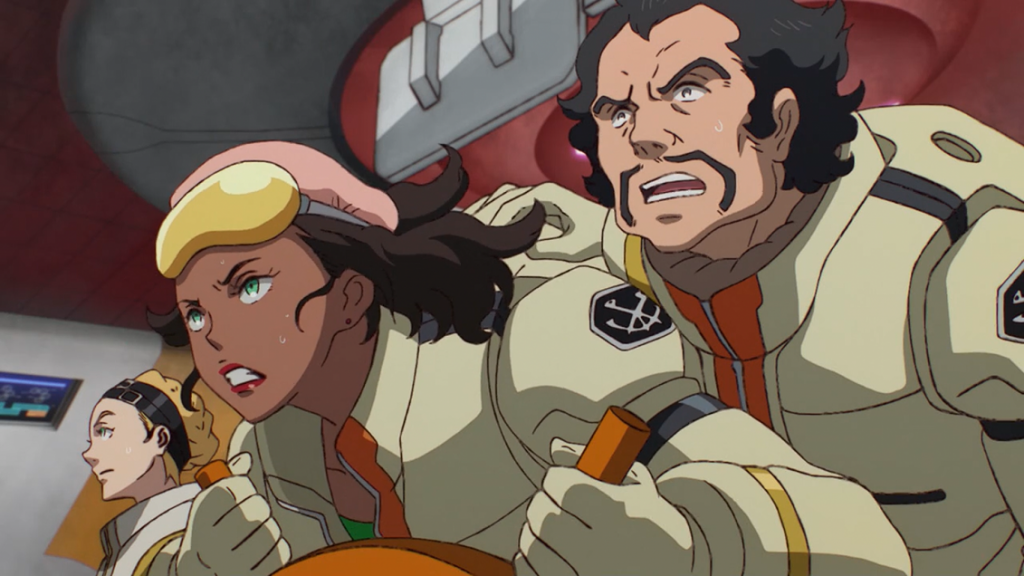
A primary concern to anyone watching a Gundam series is the quality of the mecha designs, and G-Reco certainly delivers in this regard. While the main mobile suit this time around, Bellri’s G-Self, is rather run-of-the mill (aside from its eyes and antennae making it look like a giant mechanical bunny), the other suits can be great. The Capital Guard’s Recten and Recksnow have wonderfully retrofuture designs, with heads shaped like old computer monitors and adorably clunky frames. As we get introduced to more mobile suits, particularly those in space, we see more sleek and futuristic designs, with all sorts of ridiculous weaponry. The rate at which these get introduced can be a little overwhelming, but any serious mech-head will struggle to complain once they’re all in space shooting, slashing and smashing the crap out of one another.
Another great feature is the thought that has been put into the peripherals of mobile suit operation. G-Reco often shows pilots making toilet while in their mobile suits, a need which makes perfect sense but has typically been skimmed over in the past (just as Jack Bauer apparently never takes a dump), and we see mobile suit airbags activating as pilots get smashed around their cockpits. Toilets and air bags are hardly the most exciting of mecha innovations, but it all goes towards developing the world of G-Reco.
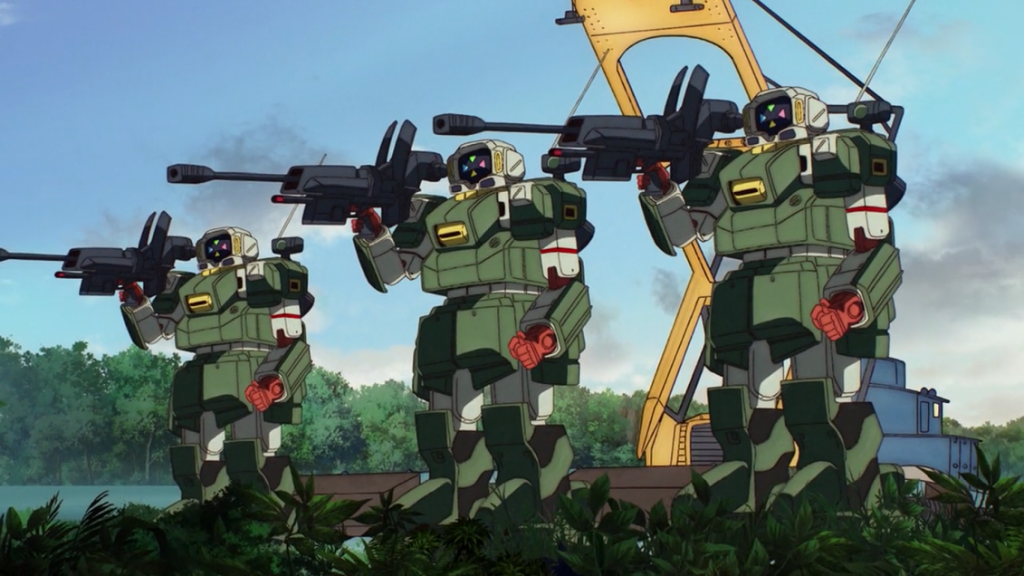
G-Reco’s animation is one of its strongest attributes; it is consistently stunning in its fluidity, whether that be the expressive body language of the characters, or the wild battles of the mobile suits. While the space-based battles tend to be more exciting, Episode 10 sees one of the best Earth-based battles: it contains some awesome animation of mobile suits brawling, with the G-Self punching and kicking an enemy unit as pieces fly off it – interestingly, this episode was storyboarded and directed by Attack on Titan’s Tetsuro Araki, who is no stranger to intense fight scenes between giant entities.
The scenery all looks excellent, and in every shot there are tons of minor background details which add great depth to the setting. Characters can be talking in the mess hall of the Megafauna, and through the window in the background one can see the deck chief shouting at his men – it’s a small detail, but helps make the ship seem real and alive. Also of note is the series’ CG: G-Reco contains what is possibly the best blend of CG and 2D animation in any anime series I have seen. The CG is used sparingly, mostly for complex space equipment like Capital Tower and space colonies, and its sleekness highlights the detailed designs, without ever seeming at odds with the traditional animation alongside it.
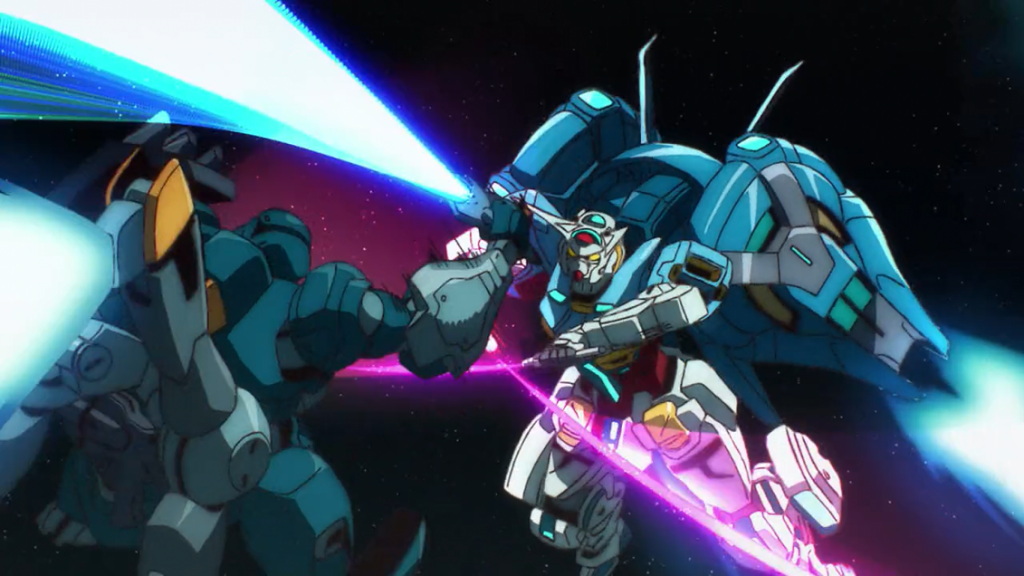
G-Reco’s music is by Yugo Kanno, and he provides a high quality orchestral score, well suiting the tone of a sweeping space opera with exciting battles. There’s an occasional issue with it being used poorly, though: some battle scenes use music that’s a little too cheery, which kind of kills the tension, and also seems inappropriate given that the pilots can (and do) die at any moment. Both of G-Reco’s openings are fairly bland J-Pop fare, but the ending theme, G no Senkou by Daisuke Hasegawa, is a pleasantly upbeat song which repeats the show’s title a bunch. It is well suited to the ending animation which displays all the characters, friend and foe alike, arm in arm doing the cancan – an odd choice, sure, but an amusing one that highlights G-Reco’s slightly brighter tone compared to previous Gundam series.
While it clearly has its flaws, for those viewers willing to put in the effort Gundam Reconguista in G delivers some great entertainment. Its mecha designs are weird and wonderful, its battles exciting (particularly once the action moves to space), and its massive cast are varied and largely likeable. Somewhere deep within the series there even lies a philosophical message: a message about moving forward as humanity despite historical divides, about not judging other peoples without first judging yourself, and about the dangers of relying on weapons to maintain peace. However, when most of one’s effort is taken up on simply trying to understand what’s going on with the story, it’s easy to see how these messages remain buried. Still, by the end of G-Reco it really does feel like you’ve been on a journey. And while that journey was confusing, and at times even nonsensical, it was bright, exciting, occasionally thought-provoking, and always a lot of fun.

On-disc extras consist only of clean opening and ending sequences, and a promotional video. The release does come, however, in a very nice box, complete with art cards and a ‘Gundam Collection’ spine which will ensure it fits well on the shelf next to Anime Limited’s other Gundam releases.

